I’ve hiked in Glacier Gorge in the summer. I’ve also hiked in Glacier Gorge in the winter. A lot, in fact. Winter in Glacier Gorge is one of my favorite things in Rocky. And while I’ve published posts on Sky Pond in summer and Sky Pond in winter and Black Lake in summer and Black Lake in winter, I realized recently that I have a large number of photos I’ve never shared from our other, shorter hikes into Glacier Gorge.
Because while Sky Pond and Black Lake are lovely, they’re also really difficult hikes in the winter, and sometimes you just might not feel like trudging through the snow for 9 miles (14.5 km) with cold wind flinging snow into your face. Sometimes, we don’t feel like doing that either. And so on these days, we only hike halfway up Glacier Gorge, stopping instead at either Loch Vale, Mills Lake, or both.
In this post, I’ll talk about how to reach these two lakes in snowy conditions and share photos of our various winter outings. Before you set out, be sure you have proper clothing and gear, including microspikes (definitely) and snowshoes (maybe, particularly if it has recently snowed).

Alberta Falls
Glacier Gorge Trailhead is located almost at the end of Bear Lake Road. In the summer, the trailhead parking lot typically fills before dawn. In the winter, we’ve found a parking space as late as 9:00am, though the lot filled to capacity very quickly after that. You can also begin just up the road at Bear Lake Trailhead. This will add a short distance to your hike, but there’s more parking here so it doesn’t usually fill quite as early.
From the trailhead, follow signs to Alberta Falls. The trail begins with a short descent before flattening out, climbing sharply, and arriving at two sequential junctions. Follow signs to stay right at the first and left at the second. Not far beyond is a bridge, and from here you have two options: bear right just shy of the bridge onto the winter trail, or cross the bridge and continue on the main trail. For Alberta Falls, cross the bridge.


Winter trail
The winter trail is a snow-only route that bypasses Alberta Falls and takes a much more direct route up to Loch Vale and Mills Lake. We typically take this route. However, it’s almost 1 mile (1.6 km) shorter than the main trail, making it a much steeper hike. Also, on our most recent hike, we encountered two hikers who had turned around because they’d accidentally gotten off trail.
Pat and I have hiked this trail enough that we recognize certain landmarks, but beware that the trail is not marked by any signs and may not be easy to follow. You’ll probably need snowshoes and a way to navigate. We use either the COTREX app or the NPS app for this purpose. With either app, be sure to download the maps and check their function prior to arrival at the trailhead.


The winter trail reconnects with the main trail just before a three-way junction, from which you can reach Lake Haiyaha, Loch Vale, and Mills Lake.
Loch Vale
To reach the three-way junction without taking the bypass, simply continue on the main trail above Alberta Falls, following signs toward Loch Vale. The trail zigzags up the hillside along Glacier Creek and then curves around into a more open area, from which you can see the mountains behind Loch Vale.

After this long, straight, and fairly flat stretch, the trail re-enters the trees and arrives at the three-way junction. At the signs, follow the middle fork to Loch Vale.
Now on the Loch Vale trail, if it has recently snowed you may need to swap out your microspikes for snowshoes. There are two options for this trail as well. Option one is to follow the normal summer route, which cuts across the hillside above Icy Brook and then climbs the hill in a series of switchbacks before depositing you in an open area just shy of Loch Vale.

Option two is to follow the trail initially, and then split off and follow the winter shortcut that travels on top of Icy Brook. Obviously, this is only safe when the snow and ice are stable. It’s also a much steeper route, as you’re walking directly up the gorge until you reach Loch Vale. We’ve done both, and they’re both challenging in their own right, but I think the winter shortcut is harder.


Either way, you’ll eventually flatten out and reach Loch Vale.


As you approach the lake, expect to be buffeted by the wind that seems to be a near permanent fixture here in the winter. On our most recent hike, the wind was particularly gusty, and had created a lot of neat patterns in the snow.



Braving the wind is worth it, though, for the scenery. Despite the fairly consistent snow cover, the lake always looks a little different. This is a hike I’ve done many times, and it’s one I will probably do many more times in the future.


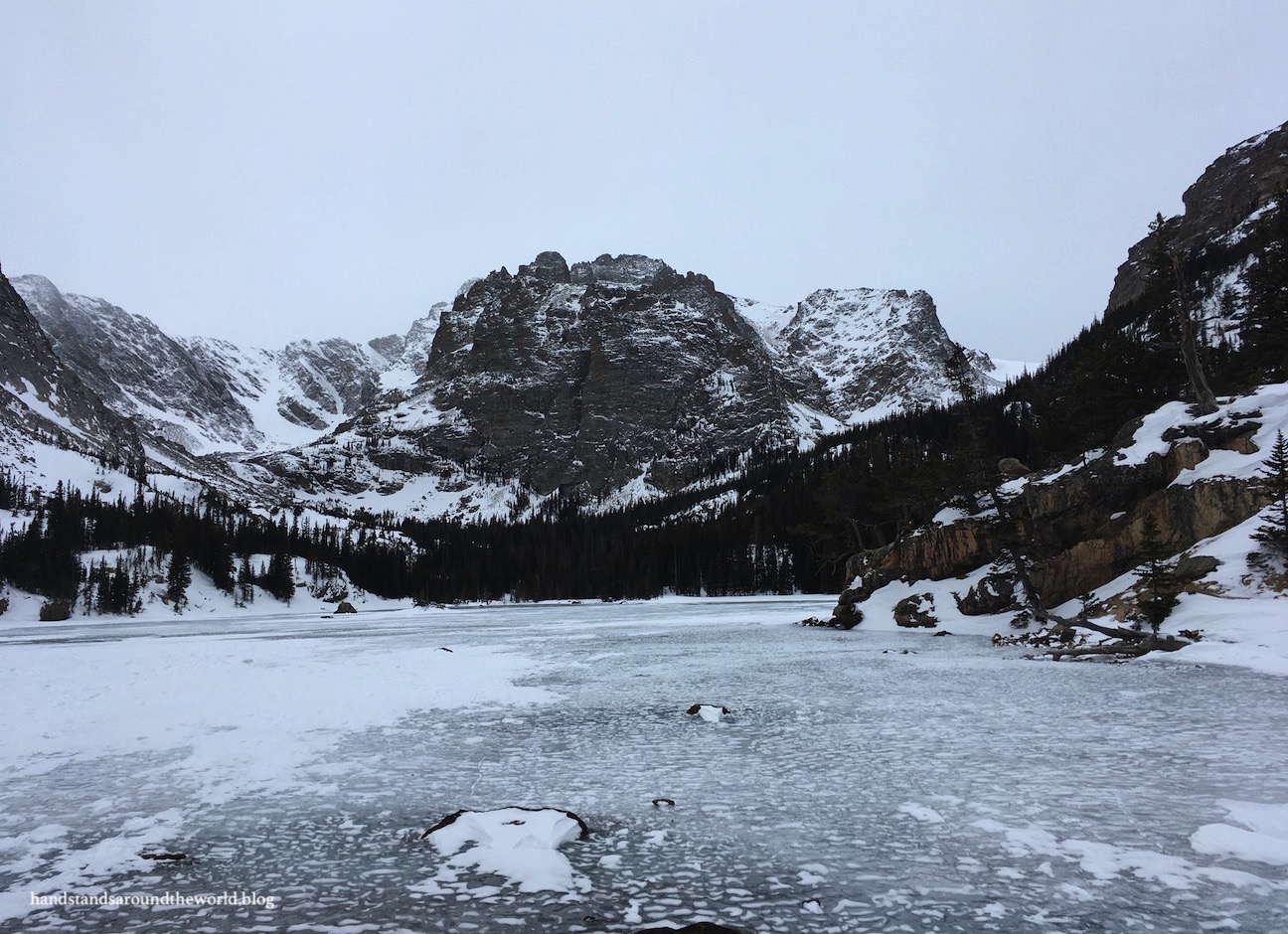

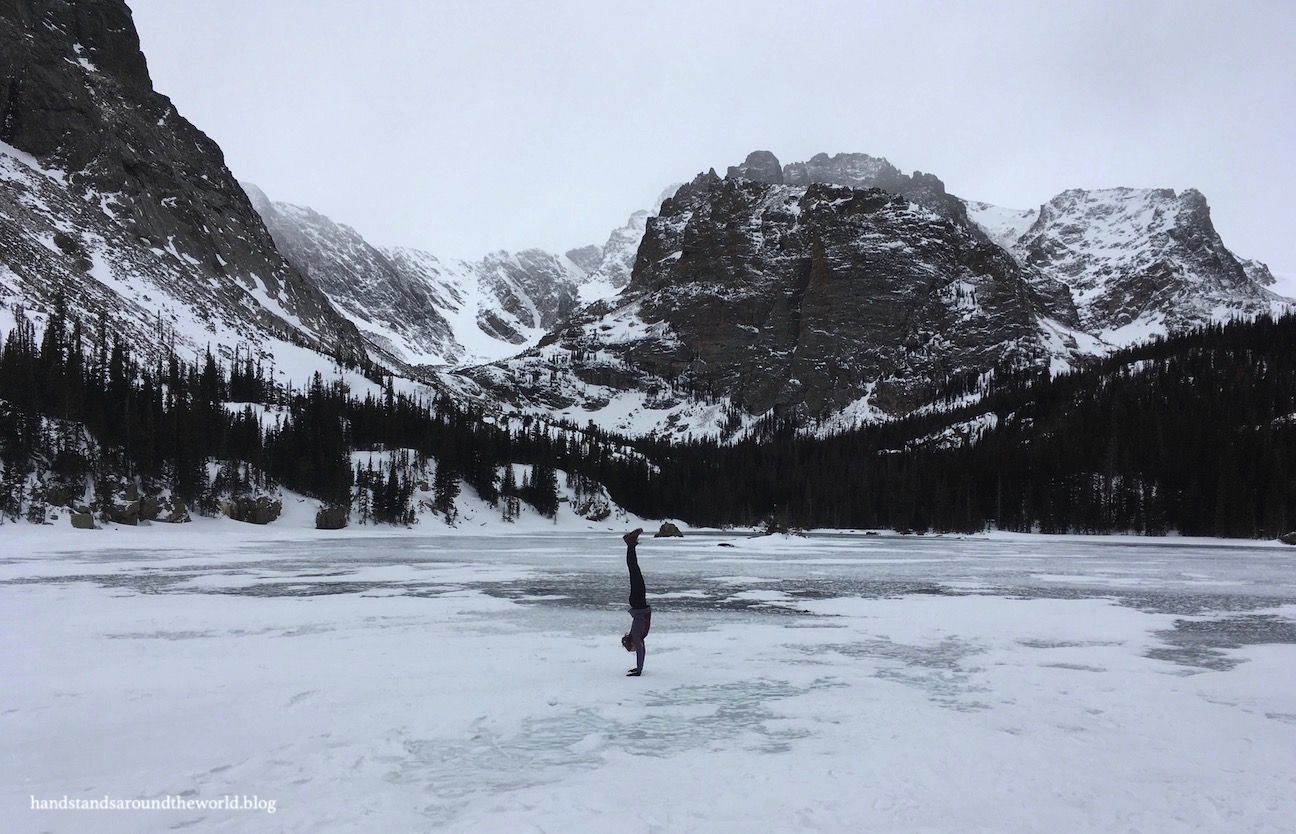
Mills Lake
While Loch Vale is a worthwhile hike of its own, it’s possible to combine it with a trip up to Mills Lake, something we have done a couple times. Alternately, you can just hike straight to Mills Lake. Either way, follow the main or winter routes mentioned above to the three-way trail junction. From here, take the leftmost fork, following signs to Mills Lake.
The trail crosses a bridge (which is often very slippery – in fact, we once saw someone almost fall into the creek below) and then begins to climb. It then crosses another bridge and flattens out on the final approach to Mills Lake. You may or may not need snowshoes on this section of trail; in my experience, it is typically more packed and windblown than the Loch Vale trail.
There are many rocky outcrops along the shore of Mills Lake, providing various options for places to sit and enjoy the view. It will probably also be windy here, but some of the outcrops might provide a bit of shelter. As with Loch Vale, Mills Lake always looks a little different depending on the sunshine, weather, and patterns on the ice.
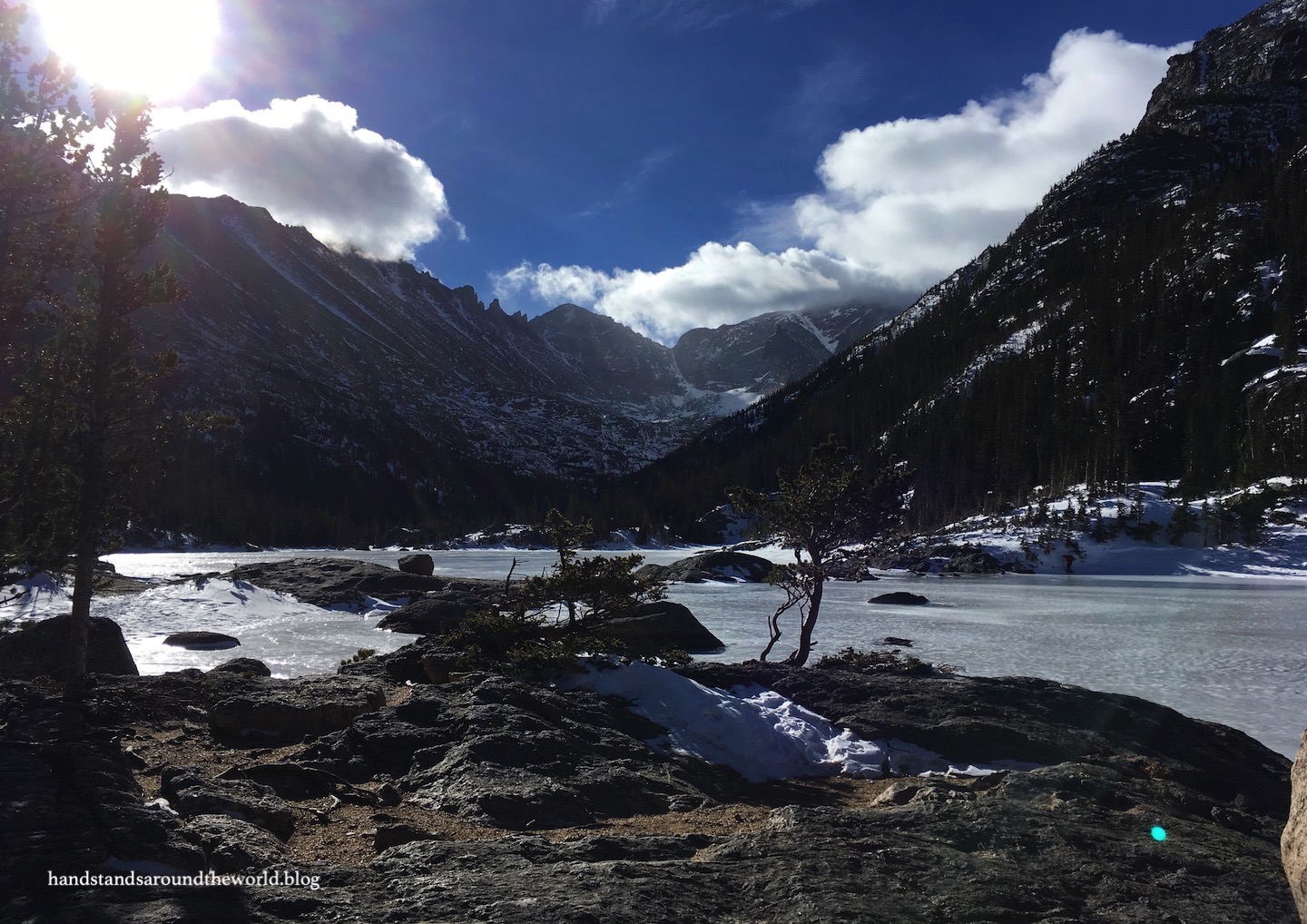

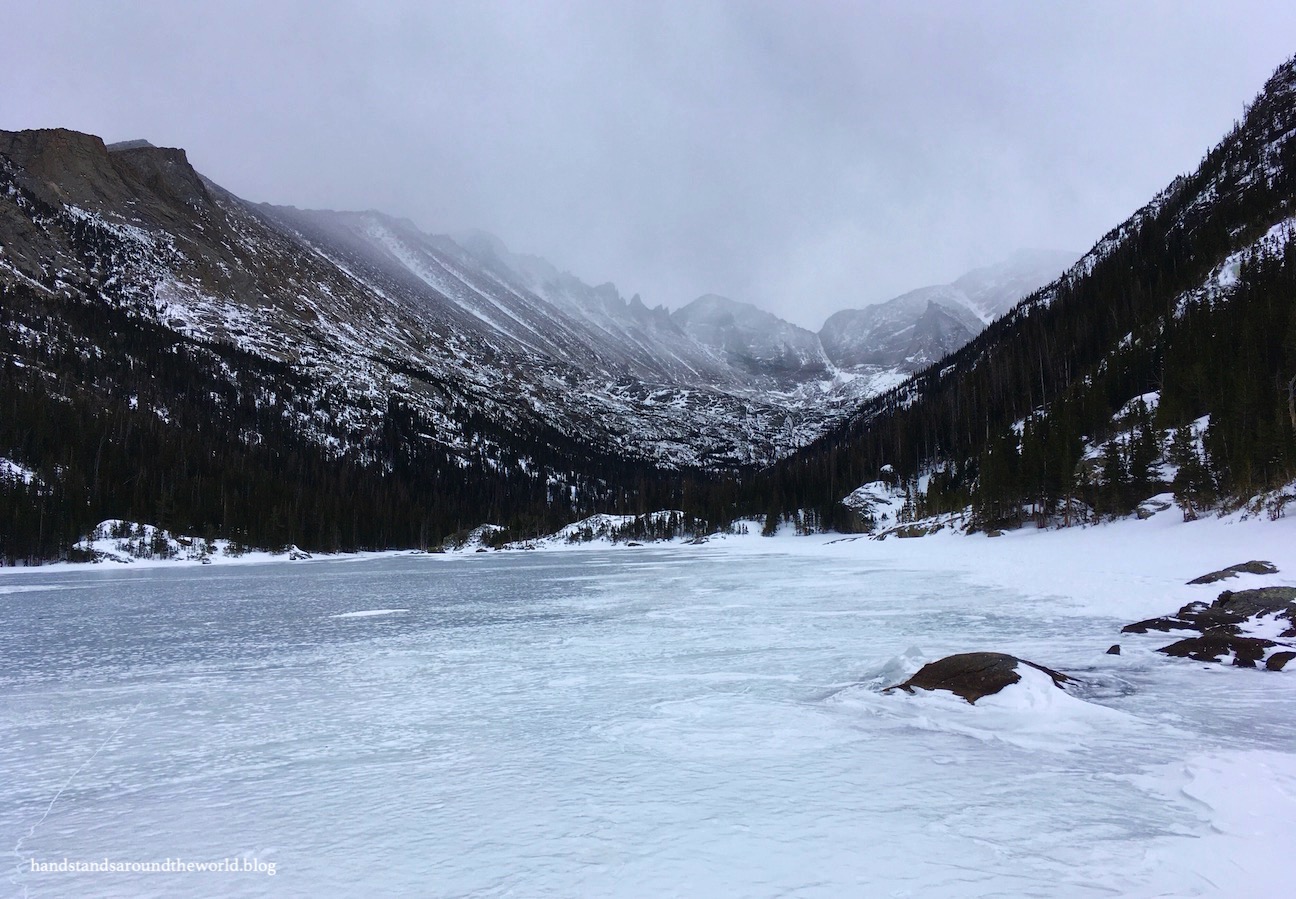

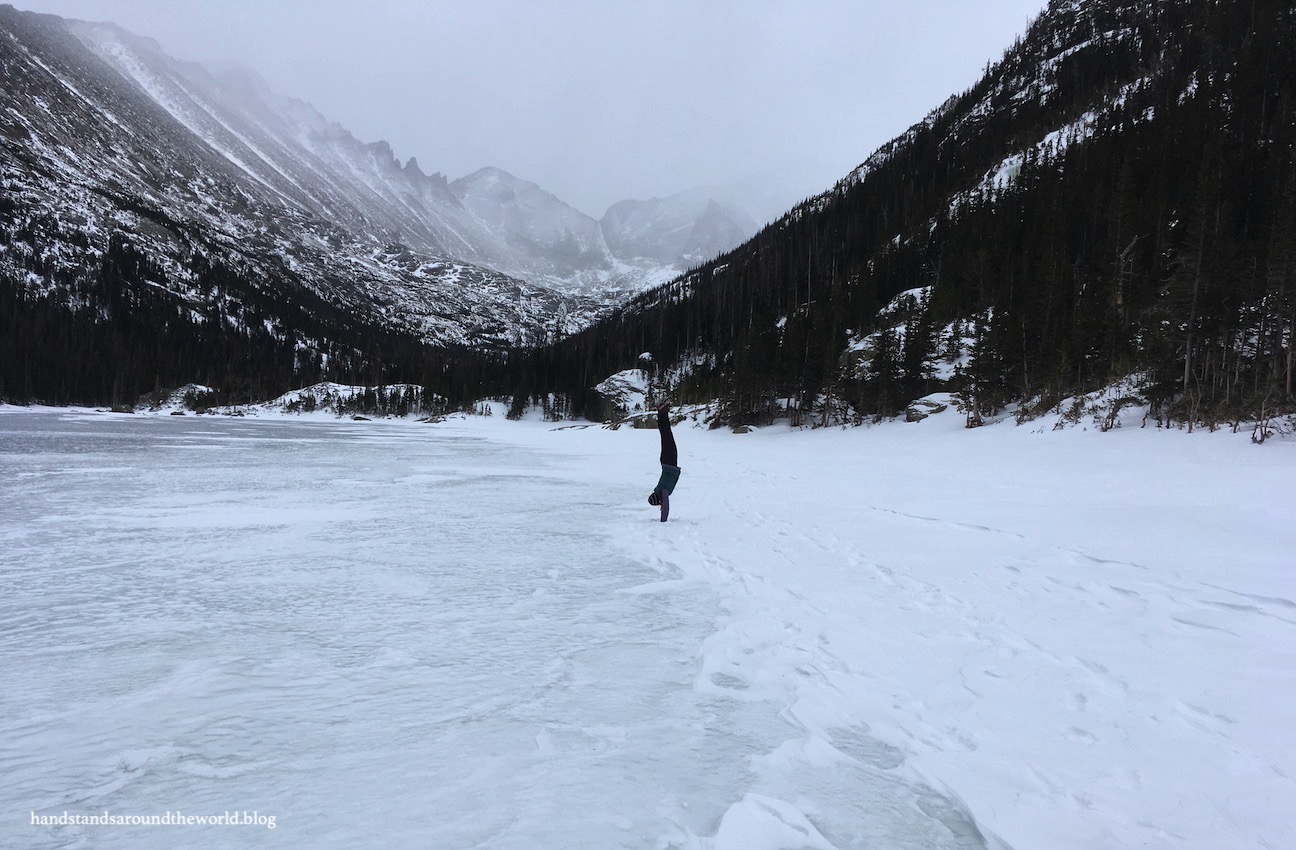
Up next: Nymph, Dream, and Emerald Lakes, Rocky Mountain National Park
The Important Stuff:
- Getting there: these hikes depart from the Glacier Gorge Trailhead near the end of Bear Lake Road. In the winter, plan to arrive by 9:00am at the very latest to secure parking. In the summer, consider leaving your car at the park-n-ride and taking the free shuttle to the trailhead. Otherwise, you’ll need to arrive before dawn to find a parking space
- Fees and passes: there is a $30/car daily or $35/car weekly entrance fee to RMNP; interagency annual passes are accepted. From May-Oct, if you arrive after 5:00am you will also need a timed entry permit to access this trailhead. Outside of that window, no timed entry permits are needed
- Hiking: round trip distances from the Glacier Gorge trailhead are as follows:
- Alberta Falls: 1.6 miles (2.6 km) with 200 feet (60 m) elevation gain
- Loch Vale: 4 miles (6.4 km) with 1050 feet (320 m) elevation gain via the winter trail; add 2 miles (3.2 km) if taking the main trail
- Mills Lake: 3.6 miles (5.8 km) with 800 feet (245 m) elevation gain via the winter trail; add 2 miles (3.2 km) if taking the main trail
- Loch Vale + Mills Lake: 5.2 miles (8.4 km) with 1250 feet (380 m) elevation gain; add 2 miles (3.2 km) if taking the main trail
For more information on the park and how to prepare for hiking in the snow, see my posts on visiting Rocky Mountain National Park and winter hiking tips and safety


Wow, Taylor Peak at the head of Loch Vale is absolutely gorgeous, Diana. That alone would make the hike worth it. Nice handstand as well. –Curt
LikeLiked by 1 person
Thank you!
LikeLike
Wow, you two are certainly hardy hikers. I was happy you did the hiking here for us, through the frigid temperatures and windy conditions, and really enjoyed the scenery. Great landscapes and artistic close-ups, beautiful wind patterns. Fun to see the video clip with that fierce wind. And always amazing to see not just one, but two, handstands this time. Great post, Diana, thank you.
LikeLiked by 1 person
Thank, Jet!
LikeLike
Wow, that really is windy. It looks like you earned a very rich and calorific dinner after that hike!
LikeLiked by 1 person
I can’t remember what we had for dinner, but we definitely stopped for beers on the way home!
LikeLiked by 1 person
It’s all so beautiful. That shot of the windswept snow is really unique. I’m not sure I would brave the depth of some of that snow though!
LikeLiked by 1 person
It’s almost a step-by-step guide, but the details are certainly useful so as not to get lost. The photos are spectacular, but they’re freezing!
LikeLiked by 1 person
Thank you. Yes, it’s very cold here in winter!
LikeLiked by 1 person
stunning pictures from your fantastic winter hike! You give a lot of really great advice on how best to do this 🙂
LikeLiked by 1 person
Thank you!
LikeLiked by 1 person
I can usually get up the gumption to do a few serious winter hikes, but you guys are always so ready to tackle the cold and wind. I’m always impressed!
LikeLiked by 1 person
Well, I don’t know about always hahaha! But we manage to drag ourselves out every once in a while.
LikeLiked by 1 person
Great travel guide, and advice as well for hiking in snowy conditions!
LikeLiked by 1 person
Thank you!!
LikeLiked by 1 person
I’ve come to really enjoy hiking in the winter. The forest always looks so magical with all the snow. The trails are way less busy. And I’d rather deal with snow and ice than mud and bugs. These look like some great winter hikes. I’m hoping the trail conditions are okay for us to hike some of these when we pass through Rocky Mountain in a couple of weeks. I’ve packed my microspikes just in case.
LikeLiked by 1 person
I’m guessing you’ll need the microspikes! It’s usually still snowy up there this time of year. Hopefully the weather cooperates!
LikeLike
It looks like winter is a spectacular time to visit Rocky Mountain National Park as its hiking trails are covered with a blanket of snow. and it opens up a whole different set of activities and ways to enjoy the park. I haven’t hiked much in snowy conditions, because we don’t really have such a thing in Ireland, but once you are properly prepared it is a great way to reclaim the season and remain active all year long Question – do you guys have to wear microspikes? Thanks for sharing, and have a good day 🙂 Aiva xx
LikeLiked by 1 person
Hi Aiva! Yes, we always have microspikes in our packs and often wear them. We also sometimes carry snowshoes. It can be very icy or slippery on the trails. But like you said, now that we own proper gear, winter hiking is beautiful and we even manage to stay warm.
LikeLiked by 1 person
Looks like beautiful a winter wonderland. You’re brave to hike in freezing weather; well done!
LikeLiked by 1 person
It’s so pretty! Having the right gear makes a big difference. We have the layers now to keep ourselves warm even on very cold days.
LikeLiked by 1 person
I wonder if Alberta Falls is also named after Queen Elizabeth’s daughter, as our province is. The scenes are beautiful in winter. Is there backcountry skiing in this area too? Maggie
LikeLiked by 1 person
You know, I’m not sure about the origins of that one, but other things in the park are named mostly after people who were instrumental in getting it protected so I wonder if that’s where the falls name originates too. Now I’m curious.
LikeLiked by 1 person
Oh and yes, lots of backcountry skiing in the park in winter! We always see skiers.
LikeLiked by 1 person
Winter hiking has a lot of rewards, not the least of which are exercise, fresh air and snowy beauty. This looks like a great hike, but as with any winter hike, you need to be prepared. Thanks for sharing Diana. Allan
LikeLiked by 1 person
Thanks, Allan. Yes, we’ve got all the gear now so it makes it much more pleasant
LikeLiked by 1 person
So beautiful! I’ve never attempted hiking in the winter, but I can see the beauty in it. The cold + wind usually = me staying cozy on my couch haha.
LikeLiked by 1 person
It is sometimes very hard to convince myself to get off the couch and go hike, but it’s always worth it in the end!
LikeLike
Gorgeous 😍. I would love to go hiking in the snow. Do you find it harder to navigate compare to summer when you can see the path?
LikeLiked by 1 person
Yes, absolutely! It’s much harder. Luckily, Rocky is very popular even in winter, so usually the trails are at least somewhat visible. That being said, sometimes people wander off on their own paths and the signs are fully buried, so it’s easy to get off trail.
LikeLike
One this is for sure, it was freezing cold !!!
Thanks for the story and the photo’s of this more than special trip.
LikeLiked by 1 person
Cold, but worth it!
LikeLike
BBrrrrrr! Cold handstand!
LikeLiked by 1 person
Very cold haha!
LikeLiked by 1 person
Two more memorable handstands and the video, albeit short, captured perfectly the effect of the wind. Cheers
LikeLiked by 1 person
Thanks!
LikeLike
Lovely post! The park is so different in the winter and I might love it even more there. And you’re right, every time you go, it’s different. We went to Nymph, Emerald and Dream in March and it was different than in December, especially with the skiers on the trail. Love your photos taken at different times, too. Thank you!
LikeLiked by 1 person
Yes, I love that trail in winter too (actually, that’s my next post!).
LikeLiked by 1 person
Can’t wait!!!
LikeLiked by 1 person
Stunning! It’s one thing to hike in warmer weather, but another to hike in wintry conditions! The snow on the trail looks so beautiful, but I’m sure one needs special shoes to hike (otherwise, I’d definitely be careful not to slip)! Thanks for sharing your experience hiking in the gorgeous Glacier Gorge, Diana!
LikeLiked by 1 person
We strap microspikes onto our shoes to prevent slippage! They’re the best invention, you can walk right across ice and not have to worry.
LikeLiked by 1 person